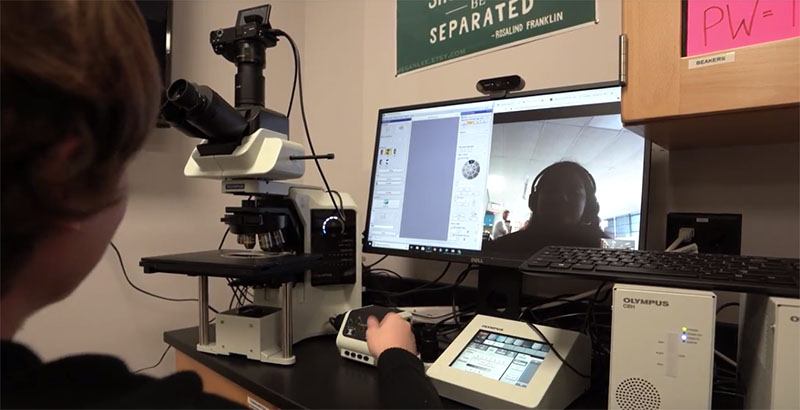Remote-Controlled High-Tech Microscope Brings Cutting-Edge Science to Tennessee HS. And Now, More Underserved Schools Are Getting In on It

Updated Feb. 12
The world of 4K microscopes is generally limited to high-level research universities. These ultra-high-definition scopes allow for enhanced detail that make a regular microscope look downright analog. But a push by the National Science Foundation and a nonprofit organization called US Ignite is opening 4K science research for under-resourced high schools across the country, bringing gigabit internet connectivity with data transfer speeds at a billion bits per second into communities such as Chattanooga, Tennessee, and Lafayette, Louisiana.
Schools where science research was largely read about in textbooks can now offer their students access to the most advanced microscopes in the country.
The program began in 2014 in collaboration with US Ignite, a nonprofit dedicated to creating a “smart city movement,” after Chattanooga’s municipal provider of internet service and fiber optics brought gigabit connectivity to the city. The University of Southern California partnered with the city’s STEM School, a public magnet school, to use the advanced fiber network to stream USC’s 4K microscope into a Tennessee high school’s biology classroom. Not only did high school juniors get to watch USC researchers use the microscope in real time and talk to them about what they were doing, but the connectivity enabled them to remotely manipulate the scope. The following year, Chattanooga students began sending their own slides to the university and using the microscope 2,100 miles away to conduct local research on water quality.
With the program such a success, funding from US Ignite and Mozilla, maker of the Firefox web browser, allowed the STEM School to add its own Olympus 4K microscope, housed in its biology classroom, in 2017. Other schools in surrounding Hamilton County then joined the program, using Chattanooga’s high-connectivity network to engage in the same type of science experience that STEM School students previously had with USC.
Now, the program has grown to include six schools, giving hundreds of students access to the Chattanooga microscope. And new funding from the foundation and US Ignite will bring in five additional schools, in Jackson, Tennessee, and Lafayette.
“This is about the STEM work, but also this network approach to education, bridging a lot of these gaps because of the quality of connections and opportunity these platforms bring students who wouldn’t otherwise speak to each other are now able to interact,” says Geoff Millener, digital equity officer at The Enterprise Center, a group supporting minority entrepreneurs and under-resourced communities and part of the team running the microscope project. “Now it becomes a collaborative network of peers, lab assistants and scientists working with each other.”
US Ignite and the center hope to roll out real-time collaborations to the additional schools this summer and offer a full classroom launch for fall semester, giving STEM curriculum to schools that wouldn’t have the opportunity without the program.
Shannon Seigle, a STEM School biology teacher, clearly remembers seeing the first image from the USC microscope in 2014: a rotifer, a microscopic aquatic animal, feeding and creating a microcurrent in the water by beating cilia back and forth like oars on a boat. “I have multiple degrees in science, and I had read about it, but to actually see it, it clicked,” she said. “I never thought I would see something in that detail and share it with people in different states. The resolution between regular microscopes and 4K is night and day.”
During biology class at STEM School, Seigle uses the 4K microscope to help students investigate the micro-impacts of organisms on local water sources. A typical unit with the microscope has students running project-based learning experiments on how human interactions impact fresh water through microbial populations. Experiments involve multiple trials with a human variable — e.g., a pollutant, such as oil — and water from a local source. Seigle said students collect data on their experiments over time and use the microscope at least three times during the process, learning how to not only manipulate the instrument but also understand the information it provides. Former STEM School juniors serve as lab assistants during their senior year.
For the remote schools, students run the same experiments with their own local bodies of water and the STEM School slides that they can examine by operating the microscope remotely over the fiber network.
“So many of our schools are on creeks, ponds and lakes that it is an experience that replicates really well across the city,” Millener said. “Students are able to compare their level of pollution in incredible detail to figure out just where on the [pollution] scale their local body of water rests.”
Jarren Carr, a senior at STEM School who took biology as a junior and is now a 4K lab assistant, said working with the microscope is different because nobody else has the ability. “You are a diamond because you have skills that nobody else has,” he said. Carr, who has an interest in mechanical engineering, said he can apply what he learned about micro distances to that field.
Ashlynn Verstrat, another STEM School student lab assistant, said that from talking with friends at other schools without access to the microscope, she realized how fortunate she is. “That gives us a leg up going into college,” she said. “For me, I have always been interested in science. To get here and do a project and work with the whole 4K team was very eye-opening. I never expected to actually get to use one of these microscopes in a high school. I definitely never expected to see living things on a scope and then be able to use it. It has been a good experience.”
An unintended benefit of the 4K microscope has been the growth of the students’ soft skills as well as their understanding of science. Along with the professional application process required to become a lab assistant, the popular program routinely brings through tours of teachers, officials and peers. “It is not just about the tech, although we are extremely lucky to have gigabit connectivity and feel having that in rural schools is an advantage,” Seigle said, “but also the personal aspect is just as important as the critical thinking.”
STEM School Principal Tony Donen said that he looks not only at the tech but also at how students are transformed. He believes the 4K microscope experience is doing that across his school. Both Carr and Verstrat, he said, were socially reserved or uninterested in academics when they entered the school. Now, Carr speaks in front of groups, welcoming staff and students every morning, and Verstrat has found a passion point that gets her excited about school.
“We are seeing things happen with students,” Donen said, “that transform their experience and how they act.”
Get stories like these delivered straight to your inbox. Sign up for The 74 Newsletter

;)
